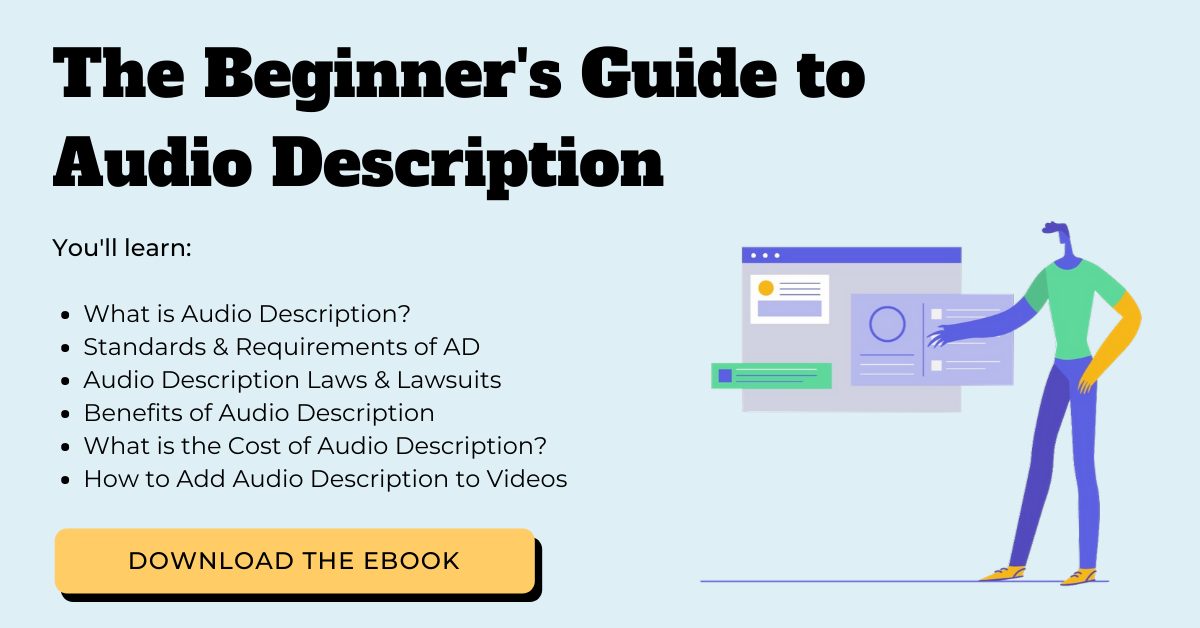A Quick Guide to Audio Description Laws and Lawsuits
Updated: July 13, 2021
Audio description is important for making videos accessible to blind and low vision people, but the laws, regulations, and legal landscape surrounding audio description can start to blend together after a while.
In this short post, you’ll find almost everything you need to know about audio description laws and lawsuits – all in one place.
What Is Audio Description?
For clarity’s sake, let’s briefly cover the definition of audio description.
Audio description, aka video description, aka described video, is “an audio track that narrates the relevant visual information in media.” Audio description is primarily an accommodation for blind and low vision users (though it does have other uses), and therefore, it dictates visual elements that are essential to understanding the content and message of a video.
Just like closed captions are critical for making videos accessible to people who are deaf or hard of hearing, audio descriptions are often essential for making videos accessible to people who are blind or low vision.
Audio Description Laws
The following section briefly summarizes audio description requirements for the Americans with Disabilities Act, the Rehabilitation Act, and the 21st Century Communications and Video Accessibility Act.
Americans with Disabilities Act (ADA)
The Americans with Disabilities Act (ADA) is a broad anti-discrimination act that requires auxiliary aids in communications to ensure that people with disabilities have access to those communications. Title II of the ADA applies to state and local government entities, and Title III applies to places of public accommodation such as hospitals, retail shops, libraries, airports, and more. Both Title II and III of the ADA require auxiliary aids for people with disabilities.
The ADA states that “A public entity shall furnish appropriate auxiliary aids and services where necessary to afford qualified individuals with disabilities, including applicants, participants, companions, and members of the public, an equal opportunity to participate in, and enjoy the benefits of, a service, program, or activity of a public entity.”
Although the ADA does not explicitly state audio description requirements, it does require that, in regards to communication, an equivalent experience must be made available to people with disabilities. Without audio description, many people who are blind or low vision would not have access to an equivalent video experience.
Even though the ADA was created before the onset of the internet and online video, providing auxiliary aids has always remained a requirement. The terminology has stayed somewhat vague, but “the Department [of Justice] has noted that technological advances…[have] increased the range of auxiliary aids and services for those who are blind or have low vision.” Therefore, it’s inferred that audio description must be provided to meet these requirements.

Access the Ebook
This White Paper is designed to serve as your comprehensive beginner’s guide to all things audio description to help you easily create accessible video content.
AccessRehabilitation Act
Under the Rehabilitation Act, a person cannot be denied participation in a program because of a disability. There are two sections of the Rehabilitation Act that we outline below: Section 504 and 508.
Section 504 applies to federal agencies and federally funded programs. Under Section 504, no person with a disability may “be excluded from the participation in, be denied the benefits of, or be subjected to discrimination under any program or activity receiving Federal financial assistance or under any program or activity conducted by any Executive agency.”
For instance, many higher education institutions receive federal funding and therefore, are required to comply with Section 504. If an institution is using video content in an educational setting, it may need to provide audio descriptions for people who are blind or low vision so that they may fully participate in classroom lectures and have equal access to course materials.
Section 508 applies to federal programs and requires that all communications and information technology be made accessible. Section 508 references explicitly the Web Content Accessibility Guidelines (WCAG) AA standards, which requires that “Audio description is provided for all prerecorded video content in synchronized media.”
Section 508 only refers to federal programs and agencies. However, similar legal standards may also apply to state schools or other state-funded programs through state accessibility policies or “little 508s.”
21st Century Communications and Video Accessibility Act
The 21st Century Communications and Video Accessibility Act (CVAA) was enacted in 2010 and addresses accessibility for video programming in the U.S. The CVAA is regulated by the Federal Communications Commission (FCC). Title II of the CVAA specifically references audio description requirements for major broadcast and subscription TV networks.
As of July 1, 2018, the regulations required that all broadcast stations affiliated with the top four commercial broadcast networks (i.e., ABC, FOX, NBC, and CBS) that are located in the top 60 designated market areas (as determined by Nielsen Company) must provide 87.5 hours of audio description per calendar quarter (approximately 7 hours per week). Of the 87.5 hour requirement, 50 hours must be prime time or children’s programming and 37.5 hours may be any type of programming between 6 a.m. and midnight.
Subscription TV systems, such as Discovery, HGTV, and USA, with 50,000 or more subscribers must also provide 87.5 hours of audio description per calendar quarter (approximately 7 hours per week), 50 hours of which must be prime time or children’s programming and 37.5 hours may be any type of programming between 6 a.m. and midnight.
For both broadcast networks and subscription TV systems, the audio description track must be passed through the television’s secondary audio program (SAP) unless the secondary audio stream is being used for the program in another way.
Note: To determine which accessibility laws apply to your organization and how to stay compliant, please consult a legal professional.
10 Questions to Ask an Audio Description Vendor ➡️
Audio Description Lawsuits
The following are just some of the lawsuits filed against corporations who failed to follow audio description requirements under U.S. accessibility laws such as the Americans with Disabilities Act.
AMC Theaters
In 2016, a lawsuit was filed against AMC Theaters (AMC Entertainment, Inc.) for not properly equipping blind and low vision patrons with audio description devices, i.e., visually impaired customers would receive malfunctioning audio description equipment or be provided with captioning devices that are typically used by deaf and hard of hearing individuals. In 2017, a two-year settlement deal was reached in which AMC agreed to train employees how to use and set up audio description devices and how to test the devices weekly. A stipulated request to dismiss the case was approved by U.S. District Judge Yvonne Gonzalez Rogers provided that AMC Theater follows through with its commitment to ensuring access to entertainment for blind and low vision patrons.
Hamilton
A class-action complaint was filed in 2017 against Broadway musical Hamilton after a blind man was not provided with audio description services while attending the show with his wife. Theaters are considered places of public accommodation, and under Title III of the ADA, they must provide auxiliary aids as accommodation for people with disabilities. Auxiliary aids include audio description for blind or low vision attendees. Though the plaintiff’s attorney did not seek damages for their client, the goal of the suit is to make sure that theaters and other places of public accommodation are more accessible and inclusive in the future.
ACB vs. Hulu
A lawsuit was filed in 2017 by the American Council of the Blind (ACB) against Hulu who was in violation of the Americans with Disabilities Act for discriminating against blind and low vision people for not providing audio description for movies or TV shows. In 2018, ACB and Hulu reached a settlement agreement in which Hulu committed itself to increase the accessibility of its streaming video services. Hulu will now work towards offering audio description for streaming video content where possible. Hulu users will also be able to enable and disable the audio description track similar to the closed captions feature. This settlement resolved the ACB vs. Hulu lawsuit, which is now officially closed.
Cinemark
Cinemark Holdings, Inc. is a leading domestic and international motion picture exhibitor. California Council of the Blind and Cinemark patrons with visual impairments brought forward a dispute against Cinemark and its theaters for being inaccessible to patrons with visual impairments. In 2012, involved parties came to a settlement agreement in which Cinemark committed to providing audio description in all of its first-run theaters by mid-2013. The settlement agreement resolved the dispute and each party avoided any burden, expense, and risk of potential litigation.
You can use this guide to begin navigating the world of audio description and to strengthen your knowledge of accessibility laws. By making accessibility a priority, your organization will give millions of people with disabilities access to your content.
Do you still have more questions about audio description? Read The Beginner’s Guide to Audio Description

Disclaimer: This blog post is written for educational and general information purposes only, and does not constitute specific legal advice. This blog should not be used as a substitute for competent legal advice from a licensed professional attorney in your state.
Further Reading

Subscribe to the Blog Digest
Sign up to receive our blog digest and other information on this topic. You can unsubscribe anytime.
By subscribing you agree to our privacy policy.








